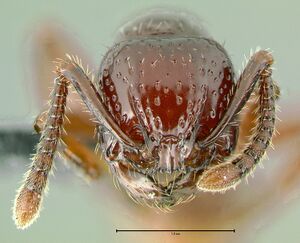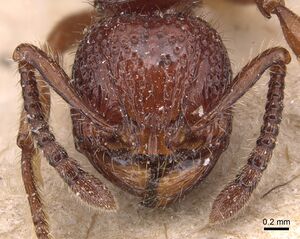Pristomyrmex picteti
| Pristomyrmex picteti | |
|---|---|

| |
| Scientific classification | |
| Kingdom: | Animalia |
| Phylum: | Arthropoda |
| Class: | Insecta |
| Order: | Hymenoptera |
| Family: | Formicidae |
| Subfamily: | Myrmicinae |
| Tribe: | Crematogastrini |
| Genus: | Pristomyrmex |
| Species: | P. picteti |
| Binomial name | |
| Pristomyrmex picteti Emery, 1893 | |
| Synonyms | |
| |
This species occurs in rainforest, nesting in rotten logs. It has been collected on the ground, on rotten wood, and under loose bark of a log.
Identification
Wang (2003) - Worker. Masticatory margin of mandible with four teeth (an apical + a preapical + two broad-based short teeth of similar size), lacking a distinct diastema; eyes small, with three to four ommatidia in the longest row; propodeal spines fairly long, about 1.3 to 1.5 X the distance between their bases, not strongly upcurved at their apices.
Pristomyrmex picteti occurs in Papua New Guinea, Borneo, Sabah, Brunei, Malaya, Singapore, and the Philippines. It is closely related to several other species of the umbripennis group. A discussion regarding the relationship between P. picteti and Pristomyrmex fuscipennis is provided under P. fuscipennis. Characters separating P. picteti from Pristomyrmex umbripennis are listed under P. umbripennis. The workers of P. picteti differ from those of Pristomyrmex pollux as follows: P. picteti - Propodeal spines relatively short, not strongly upcurved at their apices, Smaller species with HL 1.04-1.36, HW 1.02-1.40 and SL 0.92-1.26. Dorsum of head with scattered foveolate punctures; space between foveolae often smooth. Anterior margin of the median portion of clypeus usually with fewer than seven denticles. P. pollux - Propodeal spines relatively long, strongly upcurved at their apices. Larger species with HL 1.42-1.54, HW l.42-1.58, and SL 1.40-1.52. Dorsum of head with foveolate-reticulate sculpture. Anterior margin of the median portion of clypeus usually with seven denticles.
A member of the Umbripennis species group
Keys including this Species
Distribution
Latitudinal Distribution Pattern
Latitudinal Range: 9.44° to -9.25°.
| North Temperate |
North Subtropical |
Tropical | South Subtropical |
South Temperate |
- Source: AntMaps
Distribution based on Regional Taxon Lists
Indo-Australian Region: Borneo, Indonesia (type locality), Malaysia, Malaysia, New Guinea, Philippines, Singapore.
Distribution based on AntMaps
Distribution based on AntWeb specimens
Check data from AntWeb
Countries Occupied
| Number of countries occupied by this species based on AntWiki Regional Taxon Lists. In general, fewer countries occupied indicates a narrower range, while more countries indicates a more widespread species. |

|
Estimated Abundance
| Relative abundance based on number of AntMaps records per species (this species within the purple bar). Fewer records (to the left) indicates a less abundant/encountered species while more records (to the right) indicates more abundant/encountered species. |

|
Biology
|
Castes
Worker
  
| |
| . | Owned by Museum of Comparative Zoology. |
Images from AntWeb
   
| |
| Lectotype of Pristomyrmex picteti. Worker. Specimen code casent0904692. Photographer Will Ericson, uploaded by California Academy of Sciences. | Owned by MSNG, Genoa, Italy. |
Nomenclature
The following information is derived from Barry Bolton's Online Catalogue of the Ants of the World.
- picteti. Pristomyrmex picteti Emery, 1893e: 190 (w.) INDONESIA (Sumatra). Forel, 1912d: 107 (q.m.). Senior synonym of tingiana: Wang, M. 2003: 518.
- tingiana. Pristomyrmex picteti var. tingiana Stitz, 1925: 120, fig. 4 (w.) PHILIPPINES. Junior synonym of picteti: Wang, M. 2003: 518.
Unless otherwise noted the text for the remainder of this section is reported from the publication that includes the original description.
Description
Worker
Wang (2003) - TL 4.10-.5.84, HL 1.04-1.36, HW 1.02-1.40, CI 96-108, SL 0.92-1.26, SI 85-97, EL 0.05-0.09, PW 0.68-0.88, AL 1.12-1.58, PPW 0.30-0.41, PPL 0.27-0.36, PPI 100-120 (n = 40).
Mandibles rather smooth or sometimes with a few longitudinal rugae. Basal margin of mandible with a broad-based, subtriangular, Short prominence or a somewhat curved lobe. Clypeus smooth and shining, except for a median longitudinal carina that usually crosses the entire clypeus but sometimes does not reach the posterior clypeal margin. Anterior margin of the median portion of clypeus (not including the margins in front of the antennal fossae) with a median denticle and two (sometimes three) lateral denticles on each side. Ventral surface of clypeus with a coarse, transverse, long carina. Palp formula 1,3. Frontal carinae usually beyond the eyes. Antennal scrobes indistinct. Frontal lobes present, partially covering the condylar bulbs of holding antennal scapes. Antennal scapes, when lying on the dorsal head, just reaching or slightly beyond the occipital margin. Lamella, encircling the base of antennal scape, usually with a broad and deep notch on the center of the dorsal surface, but in several specimens (from Palawan I., Philippines), this lamella is entire, without a notch. Eyes very small, usually with three, at most four, ommatidia in the longest row. Occipital margin straight or very feebly concave in full-face view. Alitrunk in profile with a convex dorsum. Pronotum unarmed. Propodeum with a pair of fairly long spines, ca. 1.3 to 1.5 X the distance between their bases; sometimes the spines are weakly upcurved at their apices. Metapleural lobes rounded or somewhat truncated. Petiole node in profile slightly longer than high, with a fairly long anterior peduncle; its anterodorsal angle is usually on approximately the same level as the posterodorsal, but sometimes the former is slightly higher than the latter. Subpetiole with a narrow, semitranslucent lamella. Postpetiole in profile higher than long, rounded dorsally, in dorsal view broadening from front to back. Dorsal and ventral surfaces of head, dorsum of alitrunk, as well as the sides of pronotum with numerous foveolate punctures; space between foveolae often smooth. Antennal scapes smooth, or with one to two longitudinal rugae along their margins. Petiole smooth and shining, except for a longitudinal ruga on each side. Postpetiole and gaster smooth and shining. Dorsal surfaces of head and alitrunk with numerous erect or suberect short hairs. Two or more pairs of hairs present on the dorsal surfaces of petiole node and postpetiole, respectively. A few of forward-projecting long hairs present near the anterior clypeal margin. Scapes and tibiae with numerous erect or suberect short hairs. First gastral tergite lacking erect or suberect hairs. Color reddish-brown.
Queen
Wang (2003) - TL 6.20-7.02, HL l.32-l.64, HW 1.42-l.69, CI 103-113, SL l.21-l.56, SI 85-92, EL 0.29-0.34, PW l.14-l.42, AL l.74-2.14, PPW 0.41-0.52, PPL 0.36-0.42, PPI 110-125 (n = 13).
General shape with normal caste differences from the con specific worker; eyes much larger, usually containing more than 17 ommatidia in the longest row; other characters similar to worker.
Male
Wang (2003) - TL 4.46-5.28, HL 0.68-0.78, HW 0.69-0.80, CI 95-108, SL 0.30-0.42, SI 40-56, HWE 0.85-0.94, EL 0.35-0.39, PW 0.92-l.14; AL l.44-l.78, PPW 0.30-0.38, PPL 0.28-0.34, PPI 10.3-114 (n = 5).
Head in full-face view, including the eyes, broader than long. Clypeus convex, lacking a median longitudinal carina. Palp formula 1,3. Frontal carinae distinct, extending to the level of the posterior margins of antennal insertions. Maximum diameter of the median ocellus 0.10 to 0.12. Scapes longer than the other antennal segments, except for the apical ones. On the mesoscutum, notauli rather wide, forming a V shape, separated into several cells by narrow transverse ridges; parapsidal furrows absent. Scuto-scutellar sulcus wide, usually with five to six narrow longitudinal ridges. Propodeum armed with a pair of robust, triangular short spines. Metapleural lobes subtriangular. Middle and hind tibiae without any spurs. Petiole node in profile low, slightly longer than high, with a fairly long anterior p eduncle. Postpetiole in profile rounded dorsally, in dorsal view somewhat transversely rectangular and slightly broader than long. Dorsum of head with some small punctures, varying I from scatte red and shallow to dense and somewhat coarsely incised. Pronotum with dense foveolate punctures. Mesonotum with punctures, varying from a few scattered to numerous and from feeble, small to rather large. Propodeum rugulose. Sides of petiole with a few longitudinal rugae as well as some foveolate punctures between them. Sides of postpetiole with some shallow foveolate punctures. Gaster unsculptured. All dorsal surfaces with numerous blackish-brown long hairs; sometimes hairs somewhat stiff. Color blackish-brown; wings dusky.
Type Material
Wang (2003):
Lectotype worker, Sumatra: Deli (Bedot) (Museo Civico di Storia Naturale, Genoa), here designated, [examined].
Pristomyrmex picteti tingiana Syntype workers, Philippines: N. Palawan, Binaluan, xi- xii 1913 (C. Boettcher) (Berlin Museum für Naturkunde der Humboldt-Universität, Museum of Comparative Zoology) [examined].
References
- Emery, C. 1893g. Formicides de l'Archipel Malais. Rev. Suisse Zool. 1: 187-229 (page 190, worker described)
- Forel, A. 1912e. Ameisen aus Java beobachtet und gesammelt von Edward Jacobson. III. Theil. Notes Leyden Mus. 34: 97-112 (page 107, queen, male described)
- Wang, M. 2003. A Monographic Revision of the Ant Genus Pristomyrmex (Hymenoptera:Formicidae). Bulletin of the Museum of Comparative Zoology 157(6): 383-542 (page 518, figs. 247-250, 268, 279 worker, queen, male described, Senior synonym of picteti var. tingiana)
- Wang, W.Y., Soh, E.J.Y., Yong, G.W.J., Wong, M.K.L., Benoit Guénard, Economo, E.P., Yamane, S. 2022. Remarkable diversity in a little red dot: a comprehensive checklist of known ant species in Singapore (Hymenoptera: Formicidae) with notes on ecology and taxonomy. Asian Myrmecology 15: e015006 (doi:10.20362/am.015006).
References based on Global Ant Biodiversity Informatics
- CSIRO Collection
- Chapman, J. W., and Capco, S. R. 1951. Check list of the ants (Hymenoptera: Formicidae) of Asia. Monogr. Inst. Sci. Technol. Manila 1: 1-327
- Emery C. 1893. Formicides de l'Archipel Malais. Revue Suisse de Zoologie 1: 187-229.
- Emery C. Formiche raccolte da Elio Modigliani in Sumatra, Engano e Mentawei. Annali del Museo Civico di Storia Naturale 40: 661-722.
- Emery, C. "Formiche raccolte da Elio Modigliani in Sumatra, Engano e Mentawei." Annali del Museo Civico di Storia Naturale Giacomo Doria (Genova) (2) 20, no. 40 (1900): 661-722.
- Emery, C. "Voyage de MM. Bedot et Pictet dans l'Archipel Malais. Formicides de l'Archipel Malais." Revue Suisse de Zoologie 1 (1893): 187-229.
- Forel A. 1912. Ameisen aus Java beobachtet und gesammelt von Edward Jacobson. III. Theil. Notes Leyden Mus. 34: 97-112
- Janda M., G. D. Alpert, M. L. Borowiec, E. P. Economo, P. Klimes, E. Sarnat, and S. O. Shattuck. 2011. Cheklist of ants described and recorded from New Guinea and associated islands. Available on http://www.newguineants.org/. Accessed on 24th Feb. 2011.
- Laciny A., H. Zettel, A. Pal, and D. Zimmermann. 2016. The ant genus Pristomyrmex (Insecta: Hymenoptera: Formicidae) in the collection of the Natural History Museum Vienna. Ann. Naturhist. Mus. Wien B 118: 61-72.
- Lucky A., E. Sarnat, and L. Alonso. 2011. Ants of the Muller Range, Papua New Guinea, Chapter 10. In Richards, S. J. and Gamui, B. G. (editors). 2013. Rapid Biological Assessments of the Nakanai Mountains and the upper Strickland Basin: surveying the biodiversity of Papua New Guineas sublime karst environments. RAP Bulletin of Biological Assessment 60. Conservation International. Arlington, VA.
- Pfeiffer M.; Mezger, D.; Hosoishi, S.; Bakhtiar, E. Y.; Kohout, R. J. 2011. The Formicidae of Borneo (Insecta: Hymenoptera): a preliminary species list. Asian Myrmecology 4:9-58
- Snelling R. R. 2000. Ants of the Wapoga river area, Irian Jaya, Indonesia. In Mack, Andrew L. and Leeanne E. Alonso (eds.). 2000. A Biological Assessment of the Wapoga River Area of Northwestern Irian Jaya, Indonesia. RAP Bulletin of Biological Assessment 14, Conservation International, Washington, DC.
- Stitz H. 1925. Ameisen von den Philippinen, den malayischen und ozeanischen Inseln. Sitzungsberichte der Gesellschaft Naturforschender Freunde zu Berlin 1923: 110-136.
- Viehmeyer H. 1912. Ameisen aus Deutsch Neuguinea gesammelt von Dr. O. Schlaginhaufen. Nebst einem Verzeichnisse der papuanischen Arten. Abhandlungen und Berichte des Königlichen Zoologischen und Anthropologische-Ethnographischen Museums zu Dresden 14: 1-26.
- Wang M. 2003. A Monographic Revision of the Ant Genus Pristomyrmex (Hymenoptera:Formicidae). Bulletin of the Museum of Comparative Zoology 157(6): 383-542.
- Wang M. 2003. A monographic revision of the ant genus Pristomyrmex (Hymenoptera:Formicidae). Bulletin of the Museum of Comparative Zoology 157(6):383-542
- Zettel, H. 2006. On the ants of the Philippine Islands: 1. The genus Pristomyrmex Mayr, 1866. Myrmecologische Nachrichten 8: 59-68.

